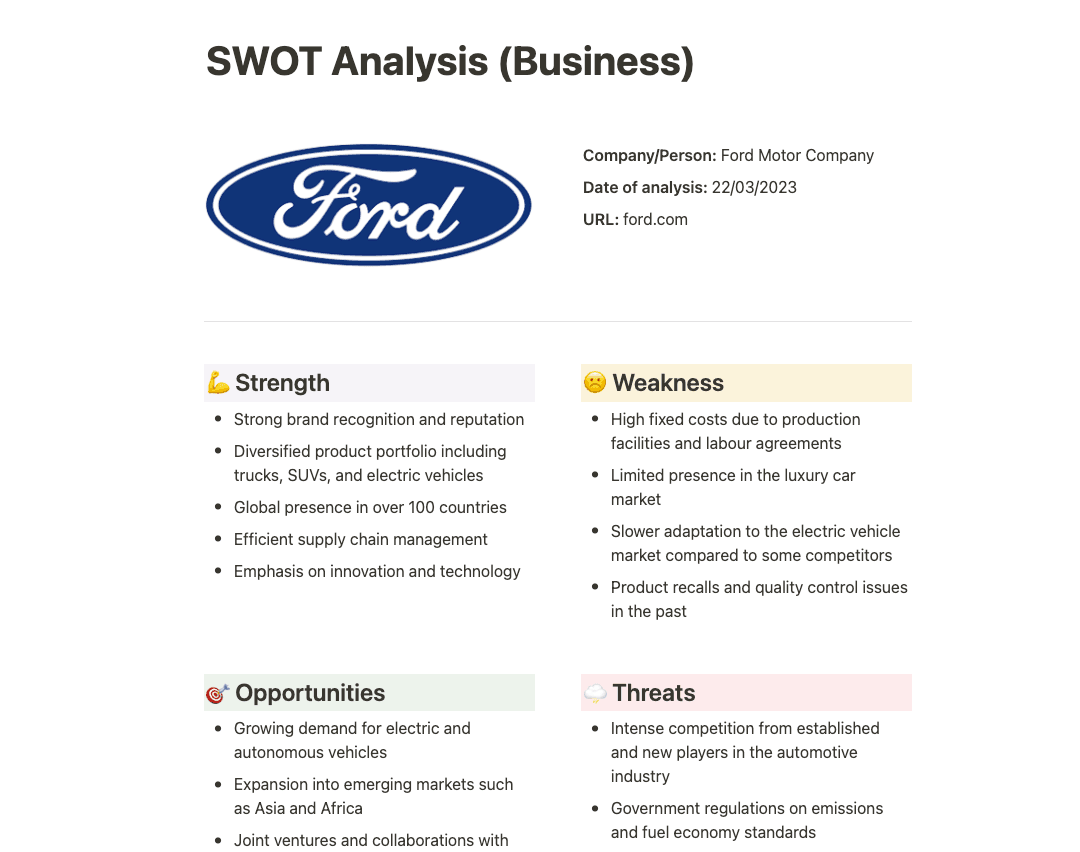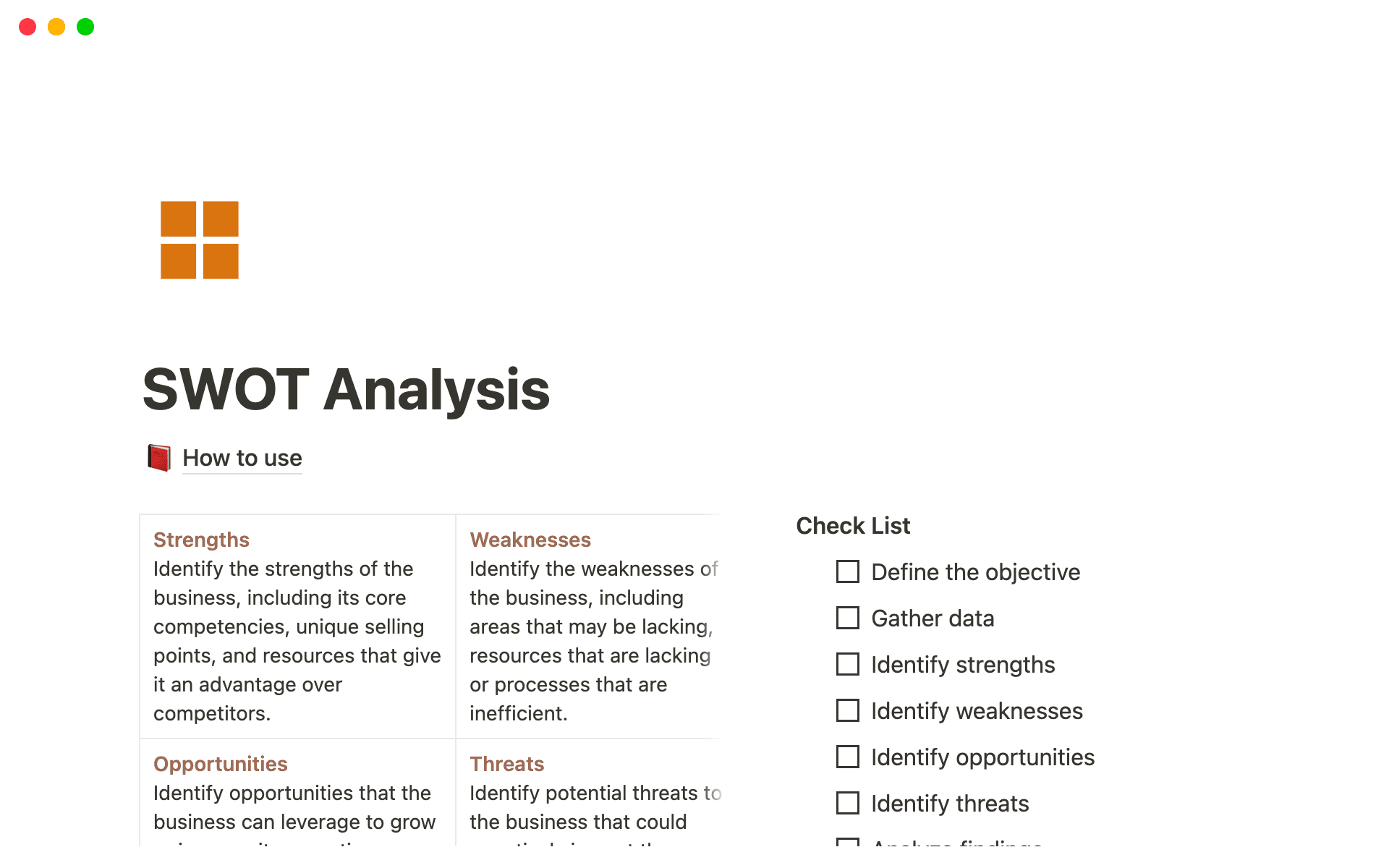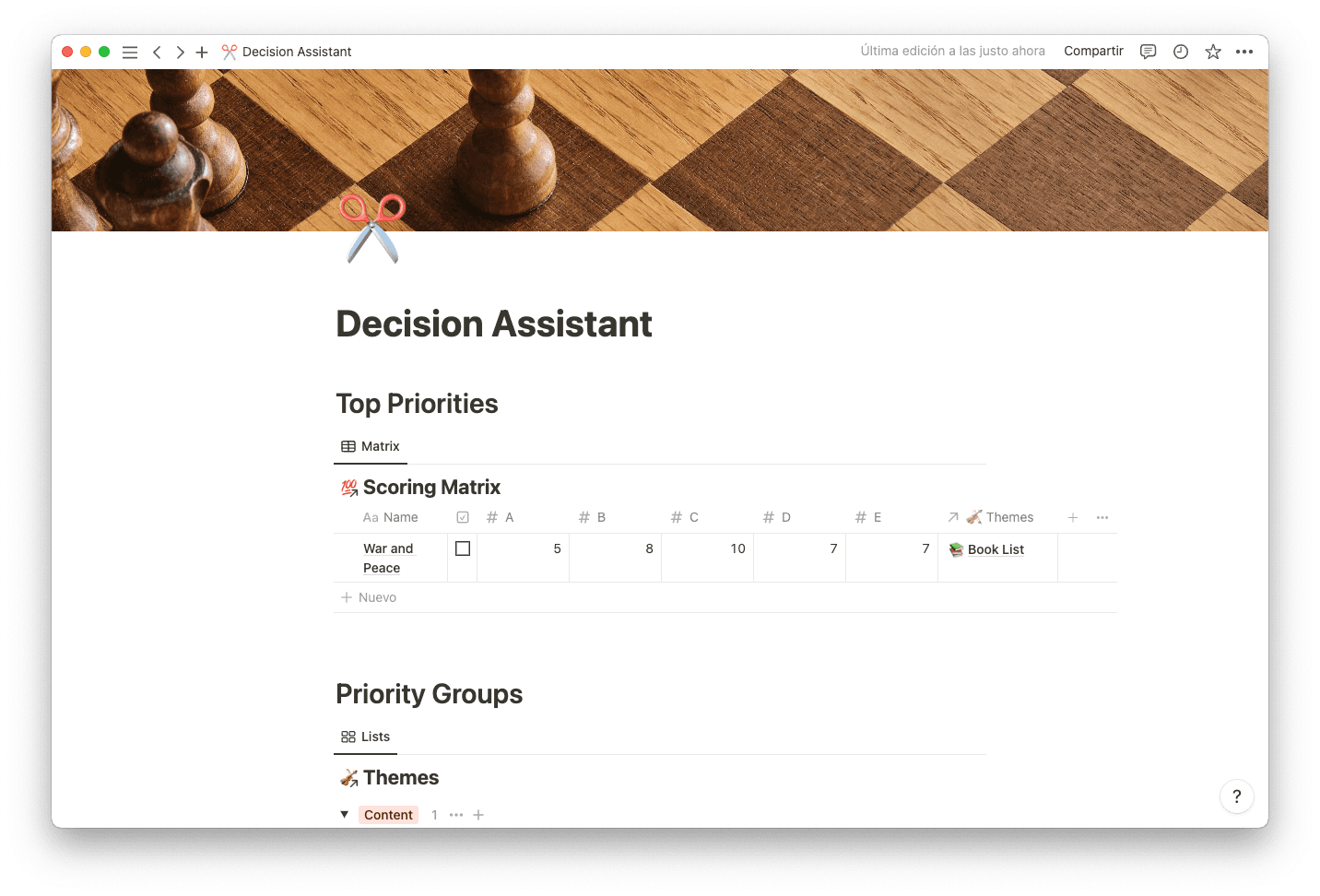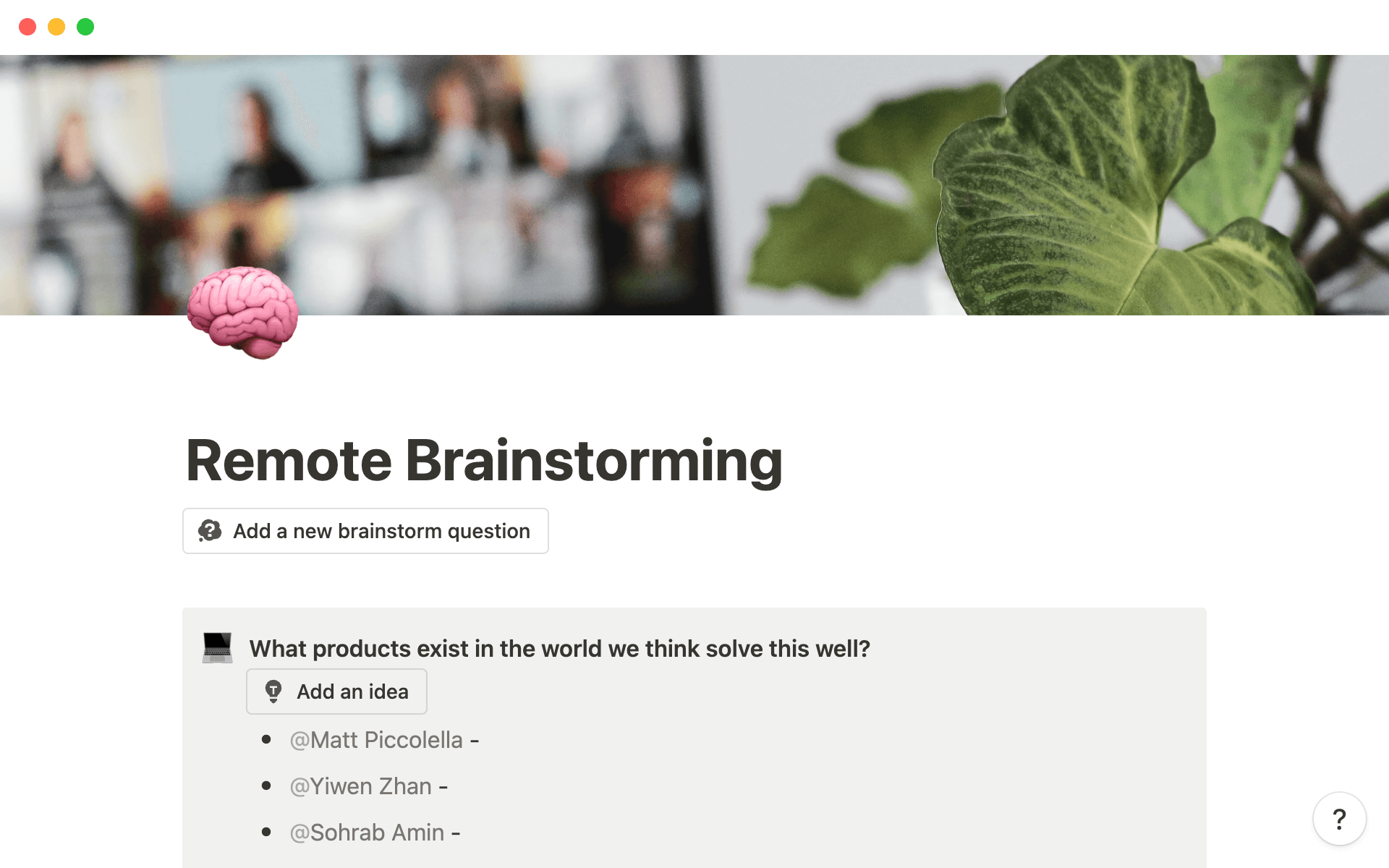Your company has an entire market of paying customers to tap into.
But you aren't the only company out there — not by a long shot. Even if you offer a niche product, there are surely at least a few competitors vying for the same audience.
Competition, product gaps, and strained resources can all put a damper on your business plan. You can’t prevent roadblocks like these, but you can plan ahead and put measures in place to prevent them.
Conducting a SWOT analysis is an actionable way to get there. Learn how to create a SWOT analysis and start weighing your strengths and weaknesses against the market’s opportunities and threats.
What’s a SWOT analysis?
A SWOT analysis — the acronym stands for strengths, weaknesses, opportunities, and threats — considers internal and external variables to help you plan strategically and spot hurdles in time to jump over them. Mapping out these four categories is a great way to assess your business's performance, competition, and potential at the same time.
Perform a SWOT analysis in these situations that call for it:
Change — Do one before implementing a massive difference in how you do business, such as switching market focus.
Launch — When pushing a company initiative, a SWOT analysis for marketing is a great way to determine viability.
Growth — If you feel like your company is stagnating, these analyses help you identify areas for development and improvement by highlighting internal strengths and weaknesses.
Performance — Anytime you need a complete overview of your business processes and overall performance, especially from different perspectives, conduct a holistic analysis.
Critical elements of a SWOT analysis
Four key elements make up a SWOT analysis: two internal (strengths and weaknesses) and two external (opportunities and threats). When combined, these elements will help your company identify where it stands and where it needs to go to improve.
Strengths
The strengths of a company are internal functions that are currently successful. To find them, you can look at what you do best and what’s unique about your business, pair it with customer sentiment, and add whatever helps you stand out against competitive companies.
Weaknesses
Weaknesses in SWOT analysis are the internal antithesis of your strengths. A weakness is any underperforming area, which gives you a starting point for improvement. Naturally, weakness doesn’t absolutely mean failure — but it does mean figuring out which specific initiatives need improvement and what resources could help.
Weaknesses often directly link to how you rank in a competitor analysis, such as coming in second to a competitor which spends more on marketing its online stores. It’s also key to ask for feedback from your team about what you could be doing better. Weaknesses aren’t just about the market; they also stem from internal practices.
Opportunities
Your SWOT analysis will help to identify opportunities: the ways you might fill gaps and gain competitive advantages. Considering available resources, the services you don’t have but could, and competitor offerings can help you adjust your business goals to better match what consumers are actually looking for. A simple example is circulating a new product or service that one-ups a competitor's.
Threats
One example of threats in SWOT analysis is a competitor launching a product that classifies yours as outdated. Other factors like industry changes, new market trends, and competitor behavior are all threats in a SWOT analysis because they’re entirely out of your control. But properly accounting for them gives you a chance to prepare and adjust your strategy when they happen.
3 benefits of a SWOT analysis
It’s not too hard to identify your strengths, weaknesses, opportunities, and threats without a proper SWOT analysis. But developing a formal process for doing so has its benefits, including:
Dreaming big
A SWOT analysis lets you wrestle your company’s biggest goals into a clearer strategy. Brainstorming the things you’re already good at, along with the obstacles you might run into, lets you turn insights into strategic benchmarks. It’s a way of organizing your ideas and setting them up for success.
Defining variables
Think of a SWOT analysis as an inventory of your current state of affairs. Rather than throwing things at a wall to see what sticks, you can log and track everything that affects your business from top to bottom. You’ll organize and clarify all of your research and self-evaluation.
Accounting for trouble
There will be obstacles to your success, no matter how tight your strategy is. By taking the time to identify weaknesses and threats, you can easily account for them in your business planning. When they do happen, you’ll be ready to stop them.
How to create a SWOT analysis
Generally, you'd represent a SWOT analysis through a visual matrix highlighting the four elements. The four quadrants make it easy to view without digging through stacks of paper. Using a SWOT analysis template makes sharing with your team quick and efficient.
There are six basic steps to creating a SWOT analysis:
1. Set your goals
A goal will keep your analysis focused and clear of redundant or general information that doesn't apply to your business. It could be expansion, the practicality of new products, and determining process risks. If you can't land on a goal, ask what your business needs and derive one from there.
2. Consider strengths
It's time to list your business's strengths — what you do well, what your customers like about you, and the unique aspects that set you apart from competitors. Think about revolutionary product features or even financial successes that put your business on a productive path. Don't hold back; list them all. This is the time to flesh out all your ideas.
3. Discover weaknesses
When figuring out your weaknesses, think about customer dissatisfaction, any resources you lack, and how your competitors are outpacing you. The thing to remember is that weaknesses are internal factors and you have the power to change them over time.
4. Find opportunities
Opportunities are potential advantages. They could be anything from sharing success stories to drive engagement to finding competitive gaps in emerging trends. They’re fresh opportunities that give you the chance to grow while taking advantage of your strengths.
5. Establish threats
For every opportunity out there, there's a threat. These are things like how your weaknesses affect your bottom line or market trends potentially edging away from your product. Other global, external factors, like recessions, are additional threats that you can't control but undoubtedly factor into your analysis.
6. Consolidate your lists
Finally, take everything you've written down and consolidate. A single SWOT analysis with too much data can be overwhelming, so keep it impactful and purposeful. You can always perform additional analyses in the future.
A real-life SWOT analysis example
Notion’s SWOT analysis template is a prime example of an organized, customizable analysis doc.
Let’s pretend Ford Motor Company filled this one out. It organizes strengths, weaknesses, opportunities, and threats into an easily digestible matrix with color-coded sections. This makes for an easy reference that anyone wanting updates on Ford’s place in the market can analyze.

Analysis made easier with Notion
Notion templates make your SWOT analysis a breeze by keeping everything in one place. Feed your analysis with a research dashboard template, or discover your threats with a risk register. And you can learn more about how Notion can help you create a SWOT analysis through the use case learning library.






